dashboard FIAT ULYSSE 2007 2.G Owners Manual
[x] Cancel search | Manufacturer: FIAT, Model Year: 2007, Model line: ULYSSE, Model: FIAT ULYSSE 2007 2.GPages: 254, PDF Size: 3.42 MB
Page 10 of 254
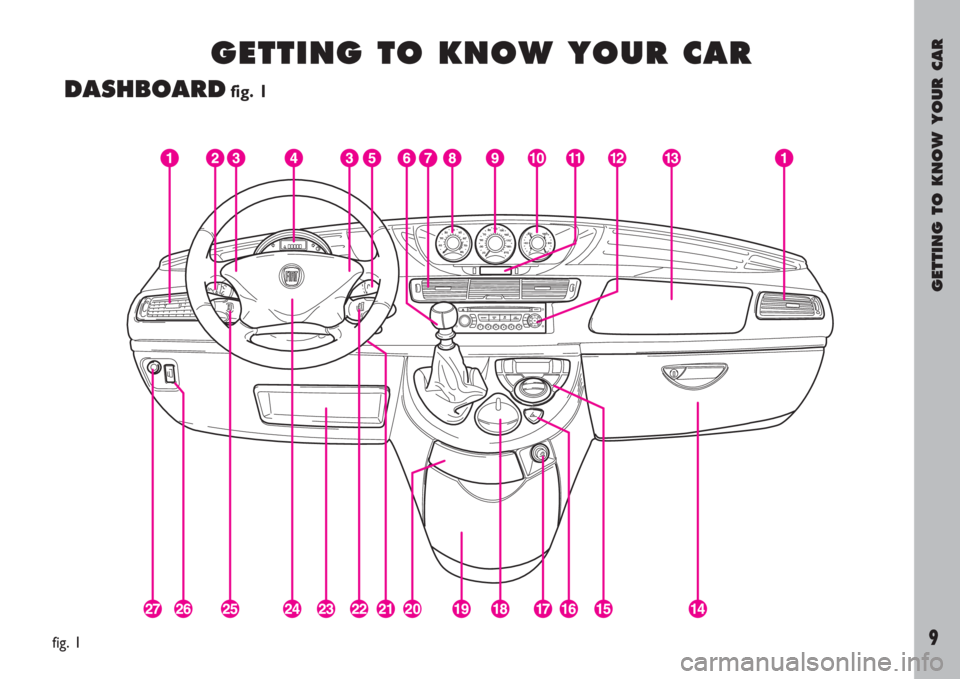
GETTING TO KNOW YOUR CAR
9
G G
E E
T T
T T
I I
N N
G G
T T
O O
K K
N N
O O
W W
Y Y
O O
U U
R R
C C
A A
R R
DASHBOARDfig. 1
fig. 1
Page 17 of 254

GETTING TO KNOW YOUR CAR
16
ELECTRONIC
ALARM
(where fitted)
The vehicle is equipped with an elec-
tronic alarm with perimeter (external)
protection and volumetric (internal)
protection. To switch on the alarm,
press the button A-fig. 8on the re-
mote control.
This will be accompanied by the di-
rection indicator flashing and then the
red led on the dashboard A-fig. 9
flashing.
Door locking by turning the key
does not activate the alarm. When the alarm is triggered
The siren comes on, the direction in-
dicators and the headlights flash for
about 30 seconds when:
– - the doors, bonnet, boot or sun-
roof (where provided) are opened;
– a variation in the volume inside the
vehicle is experienced (do not leave the
windows open or animals inside the ve-
hicle when the alarm is switched on);
– if an attempt is made to neutralise
the alarm system without the remote
control.Switching the alarm system off
To switch the alarm system off, press
button B-fig. 8on the remote con-
trol.
The direction indicators will flash
rapidly for about 2 seconds.
If the alarm system has triggered, led
A-fig. 9will flash rapidly.
fig. 8
F0B0405b
fig. 9
F0B0003b
Page 44 of 254
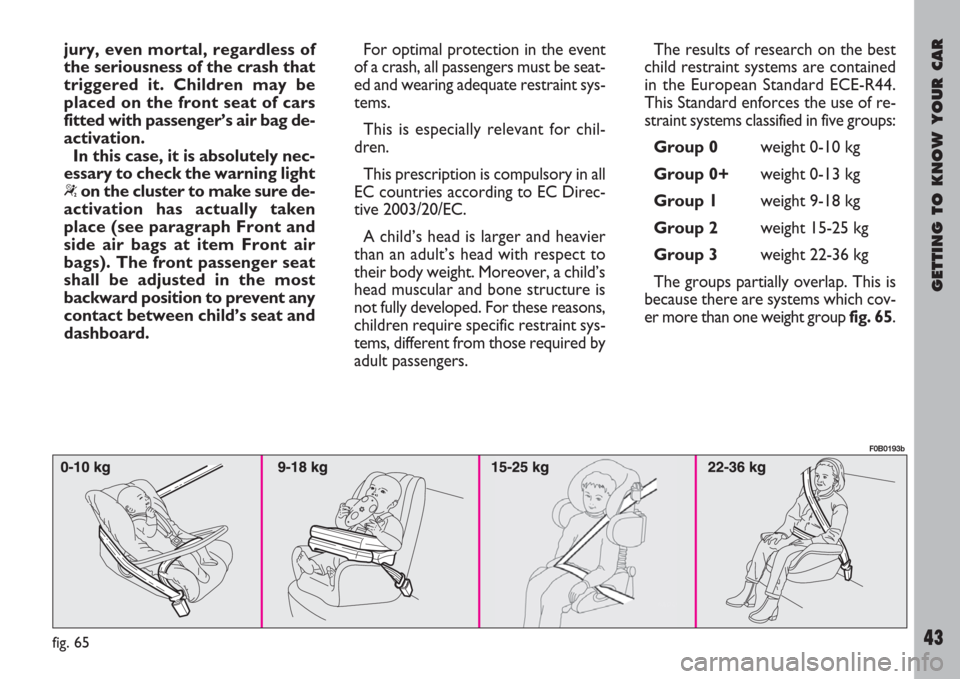
GETTING TO KNOW YOUR CAR
43
jury, even mortal, regardless of
the seriousness of the crash that
triggered it. Children may be
placed on the front seat of cars
fitted with passenger’s air bag de-
activation.
In this case, it is absolutely nec-
essary to check the warning light
“on the cluster to make sure de-
activation has actually taken
place (see paragraph Front and
side air bags at item Front air
bags). The front passenger seat
shall be adjusted in the most
backward position to prevent any
contact between child’s seat and
dashboard.For optimal protection in the event
of a crash, all passengers must be seat-
ed and wearing adequate restraint sys-
tems.
This is especially relevant for chil-
dren.
This prescription is compulsory in all
EC countries according to EC Direc-
tive 2003/20/EC.
A child’s head is larger and heavier
than an adult’s head with respect to
their body weight. Moreover, a child’s
head muscular and bone structure is
not fully developed. For these reasons,
children require specific restraint sys-
tems, different from those required by
adult passengers.The results of research on the best
child restraint systems are contained
in the European Standard ECE-R44.
This Standard enforces the use of re-
straint systems classified in five groups:
Group 0weight 0-10 kg
Group 0+weight 0-13 kg
Group 1weight 9-18 kg
Group 2weight 15-25 kg
Group 3weight 22-36 kg
The groups partially overlap. This is
because there are systems which cov-
er more than one weight groupfig. 65.
fig. 65
F0B0193b
Page 57 of 254
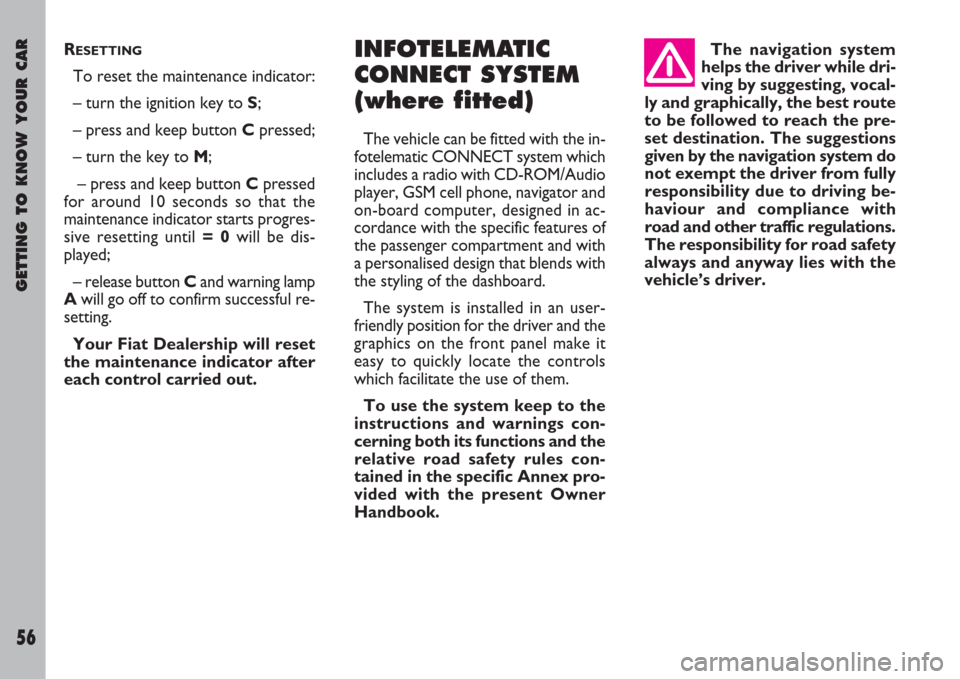
GETTING TO KNOW YOUR CAR
56
The navigation system
helps the driver while dri-
ving by suggesting, vocal-
ly and graphically, the best route
to be followed to reach the pre-
set destination. The suggestions
given by the navigation system do
not exempt the driver from fully
responsibility due to driving be-
haviour and compliance with
road and other traffic regulations.
The responsibility for road safety
always and anyway lies with the
vehicle’s driver.RESETTING
To reset the maintenance indicator:
– turn the ignition key to S;
– press and keep button Cpressed;
– turn the key to M;
– press and keep button Cpressed
for around 10 seconds so that the
maintenance indicator starts progres-
sive resetting until = 0 will be dis-
played;
– release button C and warning lamp
Awill go off to confirm successful re-
setting.
Your Fiat Dealership will reset
the maintenance indicator after
each control carried out.
INFOTELEMATIC
CONNECT SYSTEM
(where fitted)
The vehicle can be fitted with the in-
fotelematic CONNECT system which
includes a radio with CD-ROM/Audio
player, GSM cell phone, navigator and
on-board computer, designed in ac-
cordance with the specific features of
the passenger compartment and with
a personalised design that blends with
the styling of the dashboard.
The system is installed in an user-
friendly position for the driver and the
graphics on the front panel make it
easy to quickly locate the controls
which facilitate the use of them.
To use the system keep to the
instructions and warnings con-
cerning both its functions and the
relative road safety rules con-
tained in the specific Annex pro-
vided with the present Owner
Handbook.
Page 65 of 254
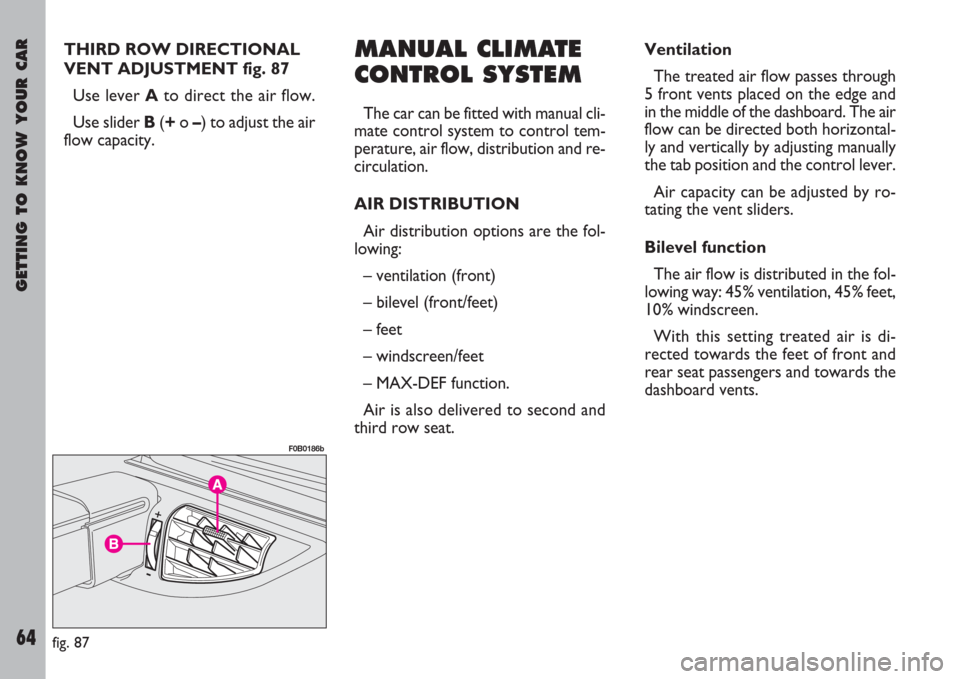
GETTING TO KNOW YOUR CAR
64
THIRD ROW DIRECTIONAL
VENT ADJUSTMENT fig. 87
Use lever A to direct the air flow.
Use sliderB(+o –) to adjust the air
flow capacity.MANUAL CLIMATE
CONTROL SYSTEM
The car can be fitted with manual cli-
mate control system to control tem-
perature, air flow, distribution and re-
circulation.
AIR DISTRIBUTION
Air distribution options are the fol-
lowing:
– ventilation (front)
– bilevel (front/feet)
– feet
– windscreen/feet
– MAX-DEF function.
Air is also delivered to second and
third row seat.Ventilation
The treated air flow passes through
5 front vents placed on the edge and
in the middle of the dashboard. The air
flow can be directed both horizontal-
ly and vertically by adjusting manually
the tab position and the control lever.
Air capacity can be adjusted by ro-
tating the vent sliders.
Bilevel function
The air flow is distributed in the fol-
lowing way: 45% ventilation, 45% feet,
10% windscreen.
With this setting treated air is di-
rected towards the feet of front and
rear seat passengers and towards the
dashboard vents.
fig. 87
F0B0186b
Page 70 of 254
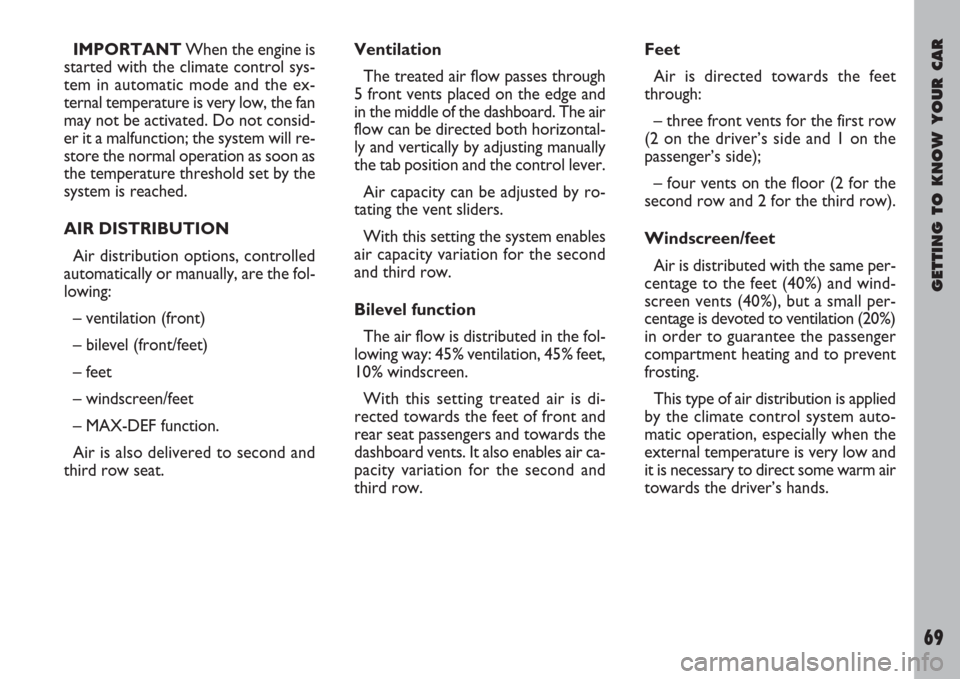
GETTING TO KNOW YOUR CAR
69
IMPORTANTWhen the engine is
started with the climate control sys-
tem in automatic mode and the ex-
ternal temperature is very low, the fan
may not be activated. Do not consid-
er it a malfunction; the system will re-
store the normal operation as soon as
the temperature threshold set by the
system is reached.
AIR DISTRIBUTION
Air distribution options, controlled
automatically or manually, are the fol-
lowing:
– ventilation (front)
– bilevel (front/feet)
– feet
– windscreen/feet
– MAX-DEF function.
Air is also delivered to second and
third row seat.Ventilation
The treated air flow passes through
5 front vents placed on the edge and
in the middle of the dashboard. The air
flow can be directed both horizontal-
ly and vertically by adjusting manually
the tab position and the control lever.
Air capacity can be adjusted by ro-
tating the vent sliders.
With this setting the system enables
air capacity variation for the second
and third row.
Bilevel function
The air flow is distributed in the fol-
lowing way: 45% ventilation, 45% feet,
10% windscreen.
With this setting treated air is di-
rected towards the feet of front and
rear seat passengers and towards the
dashboard vents. It also enables air ca-
pacity variation for the second and
third row.Feet
Air is directed towards the feet
through:
– three front vents for the first row
(2 on the driver’s side and 1 on the
passenger’s side);
– four vents on the floor (2 for the
second row and 2 for the third row).
Windscreen/feet
Air is distributed with the same per-
centage to the feet (40%) and wind-
screen vents (40%), but a small per-
centage is devoted to ventilation (20%)
in order to guarantee the passenger
compartment heating and to prevent
frosting.
This type of air distribution is applied
by the climate control system auto-
matic operation, especially when the
external temperature is very low and
it is necessary to direct some warm air
towards the driver’s hands.
Page 72 of 254
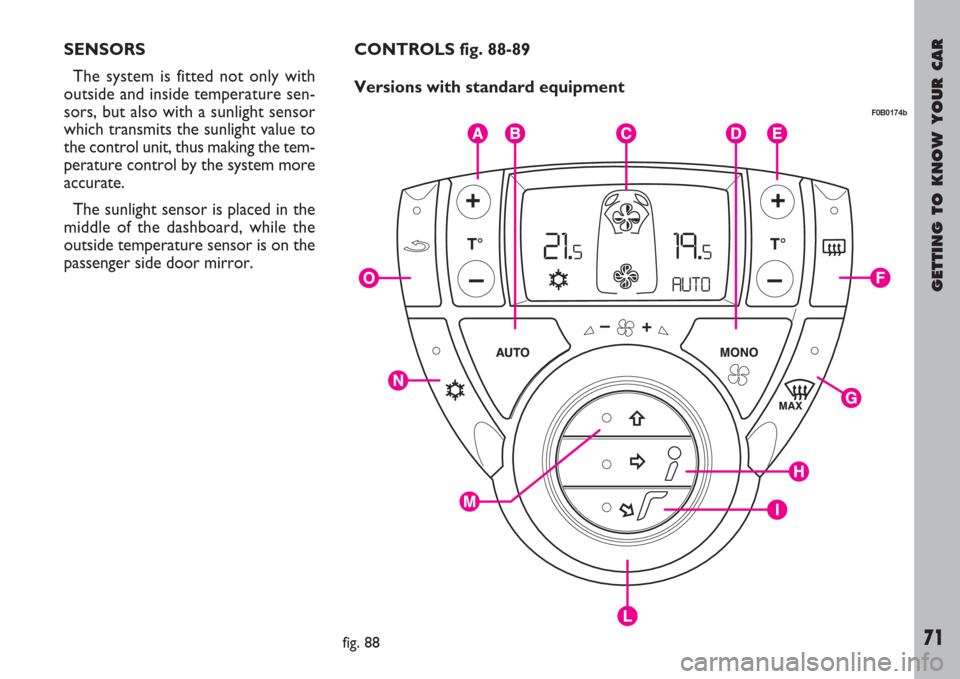
GETTING TO KNOW YOUR CAR
71
SENSORS
The system is fitted not only with
outside and inside temperature sen-
sors, but also with a sunlight sensor
which transmits the sunlight value to
the control unit, thus making the tem-
perature control by the system more
accurate.
The sunlight sensor is placed in the
middle of the dashboard, while the
outside temperature sensor is on the
passenger side door mirror. CONTROLS fig. 88-89
Versions with standard equipment
fig. 88
F0B0174b
Page 120 of 254
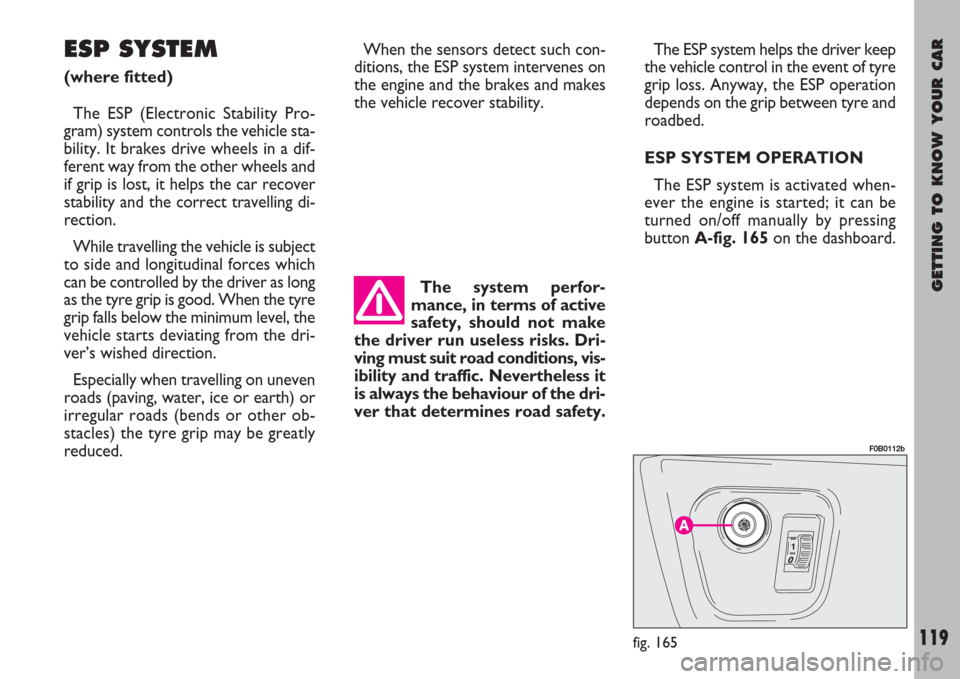
GETTING TO KNOW YOUR CAR
119
ESP SYSTEM
(where fitted)
The ESP (Electronic Stability Pro-
gram) system controls the vehicle sta-
bility. It brakes drive wheels in a dif-
ferent way from the other wheels and
if grip is lost, it helps the car recover
stability and the correct travelling di-
rection.
While travelling the vehicle is subject
to side and longitudinal forces which
can be controlled by the driver as long
as the tyre grip is good. When the tyre
grip falls below the minimum level, the
vehicle starts deviating from the dri-
ver’s wished direction.
Especially when travelling on uneven
roads (paving, water, ice or earth) or
irregular roads (bends or other ob-
stacles) the tyre grip may be greatly
reduced.When the sensors detect such con-
ditions, the ESP system intervenes on
the engine and the brakes and makes
the vehicle recover stability.
The system perfor-
mance, in terms of active
safety, should not make
the driver run useless risks. Dri-
ving must suit road conditions, vis-
ibility and traffic. Nevertheless it
is always the behaviour of the dri-
ver that determines road safety.
The ESP system helps the driver keep
the vehicle control in the event of tyre
grip loss. Anyway, the ESP operation
depends on the grip between tyre and
roadbed.
ESP SYSTEM OPERATION
The ESP system is activated when-
ever the engine is started; it can be
turned on/off manually by pressing
button A-fig. 165on the dashboard.
fig. 165
F0B0112b
Page 126 of 254
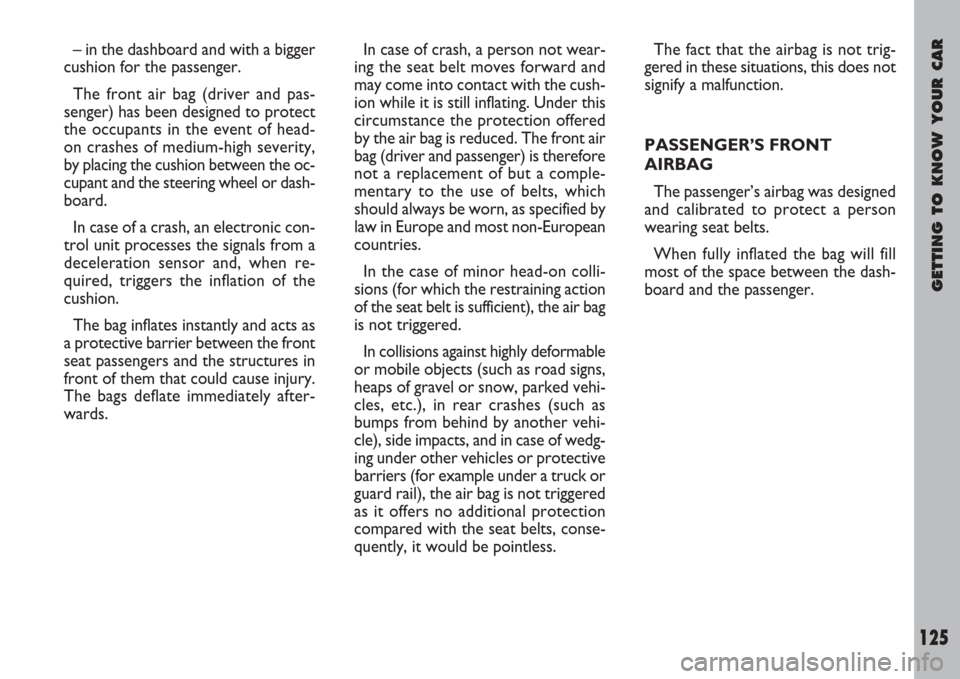
GETTING TO KNOW YOUR CAR
125
– in the dashboard and with a bigger
cushion for the passenger.
The front air bag (driver and pas-
senger) has been designed to protect
the occupants in the event of head-
on crashes of medium-high severity,
by placing the cushion between the oc-
cupant and the steering wheel or dash-
board.
In case of a crash, an electronic con-
trol unit processes the signals from a
deceleration sensor and, when re-
quired, triggers the inflation of the
cushion.
The bag inflates instantly and acts as
a protective barrier between the front
seat passengers and the structures in
front of them that could cause injury.
The bags deflate immediately after-
wards.In case of crash, a person not wear-
ing the seat belt moves forward and
may come into contact with the cush-
ion while it is still inflating. Under this
circumstance the protection offered
by the air bag is reduced. The front air
bag (driver and passenger) is therefore
not a replacement of but a comple-
mentary to the use of belts, which
should always be worn, as specified by
law in Europe and most non-European
countries.
In the case of minor head-on colli-
sions (for which the restraining action
of the seat belt is sufficient), the air bag
is not triggered.
In collisions against highly deformable
or mobile objects (such as road signs,
heaps of gravel or snow, parked vehi-
cles, etc.), in rear crashes (such as
bumps from behind by another vehi-
cle), side impacts, and in case of wedg-
ing under other vehicles or protective
barriers (for example under a truck or
guard rail), the air bag is not triggered
as it offers no additional protection
compared with the seat belts, conse-
quently, it would be pointless.The fact that the airbag is not trig-
gered in these situations, this does not
signify a malfunction.
PASSENGER’S FRONT
AIRBAG
The passenger’s airbag was designed
and calibrated to protect a person
wearing seat belts.
When fully inflated the bag will fill
most of the space between the dash-
board and the passenger.
Page 127 of 254

GETTING TO KNOW YOUR CAR
126
Deactivating the passenger’s
front air bag manually
The passenger’s front airbag can be
deactivated if it is absolutely necessary
to carry a child in the front passenger
seat.
Deactivation takes place using the ve-
hicle ignition key in the special key
switch on the right-hand side of the
dashboard fig. 170. Access to the
switch is only possible with the door
open.The key operated switch has two po-
sitions:
POSITION 1 (ON): passenger’s
front air bag activated, warning light
“
on instrument cluster off; it is ab-
solutely prohibited to carry a child on
the front seat;
POSITION 2 (OFF): passenger’s
front air bag activated, warning light
“
on instrument cluster on; it is possible
to carry a child protected by special
restraint system on the front seat.
The
“warning light on the cluster
stays on permanently until the pas-
senger’s air bag is reactivated.
The side airbag will work although
the front airbag is deactivated.
When the door is open, the key can
be inserted and removed in both po-
sitions.
fig. 170
F0B0113b
SERIOUS DANGER
The car is fitted
with an Air bag on
the passenger’s side. Do not place
a child’s seat on the front seat. In
the case of need, always deacti-
vate the passenger’s Air bag
when a child’s seat is placed on
the front seat. Even if not com-
pulsory by law, you are recom-
mended to reactivate the Air bag
immediately as soon as child
transport is no longer necessary.